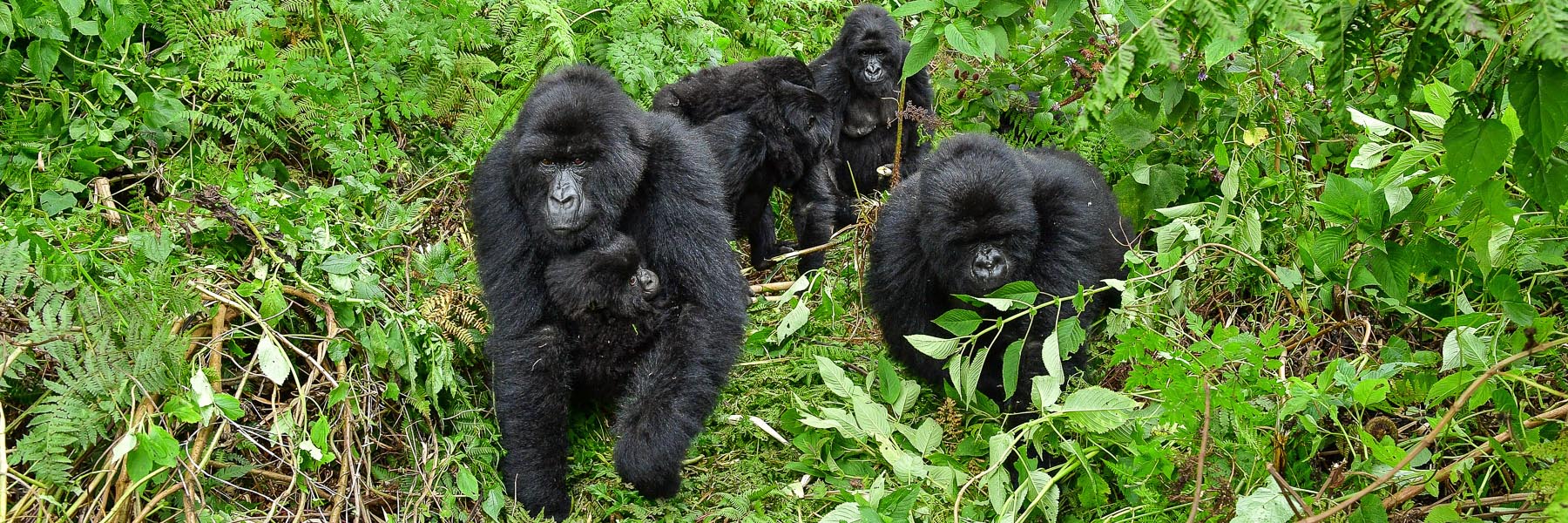The diverse terrain and vegetation of Africa, from dense forests, sprawling grasslands, to deserts, offer habitat to over two hundred different species of primates. Different primate species enjoy varying weather and food sources and therefore prefer specific regions of Africa. We discuss some of the most notable species of African primates below.
Chimpanzee
These endangered animals share almost 98% of their genetic makeup with humans, making them our closest living relatives. Less than 300,000 chimpanzees belonging to four subspecies inhabit Africa, but their numbers are dwindling rapidly. The major reasons for their declining populations are- bushmeat trade, deforestation, and illegal wildlife trade. Known for their intelligence and industriousness, these social species live in large social groups. Researchers have observed chimpanzees using tools like rocks and sharp objects to forage, making them the first non-human animals to use tools. Grooming is an important aspect of their social life, and it promotes bonding. These omnivorous animals can eat a wide range of food, including insects, eggs, nuts, and even smaller monkeys and antelopes.
The four subspecies of chimpanzees living in Africa are the Western Chimpanzee, Nigerian Chimpanzee, Central African Chimpanzee, and Eastern Chimpanzee.

Chimpanzee
Baboons
Ranging from 15kg to 37kg, baboons are amongst the world’s largest monkeys. Baboons are covered with thick fur except for their muzzles and tails. These animals prefer semi-arid habitats and savannahs of Africa. These highly social primates live in troops numbering as much as 300 individuals. The forage, travel, and sleep together. Young baboons play together, and female members of the troop have a kinship with the others. A dominant male, usually ranked by age or size, runs the troop. The primary sources of food for these omnivorous animals are seeds, berries, grass, and animals like fish, hare, earthworms, impalas, small antelopes, and birds. Baboons are aggressive and confrontational; they often fight amongst themselves for ranking and mating.
There are five distinct subspecies of baboons in Africa, namely Olive Baboon, Yellow Baboon, Guinea Baboon, Hamadryas Baboon, and Chacma Baboon.

Baboon
Colobus
Unlike other monkeys, Colobus monkeys do not have thumbs, hence their name, which is derived from the Greek word for “mutilated”. These monkeys are social, tree-dwelling, and remain active during the day. There are three genera of Colobus monkeys, each with their own subspecies- Black-and-white Colobus, Red Colobus, and Olive Colobus.
The Black-and-white Colobus monkeys have beautiful black fur and long white mantle and whiskers. Their subspecies are- Angolan Colobus, Black Colobus, Guereza Colobus, King Colobus, and White-thighed Colobus.
Red Colobus monkeys have different species, each differing in behavior, facial expressions, patterns, and vocalizations. The subspecies found in Africa are- Ashy Red Colobus, Preuss’s Red Colobus, Udzungwa Red Colobus, Western Red Colobus, and Zanzibar Red Colobus.

Colobus Monkey
Mangabey
These long-limbed quadrupedal monkeys can be recognized by their cheek pouches and deep depressions under the cheekbones. Their tails are almost as long as their head and body. Their size ranges from 16 to 35 inches. Males weigh as much as 11 kgs while females weigh about 6 kgs. These primates are highly social and communicate through specialized and loud vocalizations. Mangabeys have large front teeth that help them bite into fruit that is too hard for other animals. Their diet mainly comprises seeds, leaves, and fruit.
Their ten different subspecies are characterized by different body types and they live in different regions of Africa. Some of them are white-collared mangabey, sooty mangabey, Golden-bellied mangabey, Sanje mangabey, and Tana River mangabey.

Mangabey Monkey
Mandrills
These colorful, ground-dwelling monkeys inhabit the equatorial rainforests in Africa. They are easily identifiable thanks to their bright coloration and the thick ridges along with the nose, that range from pink, scarlet, blue, and purple. They have bare colored patches of skin on their face and buttocks, and the distinctive colors become brighter when a mandrill is excited. They live in troops headed by a dominant male. These troops, or hordes, can be as big as 800 members. Mandrills are omnivorous and feed on plants, fruits, mushrooms, and tree barks. Their sharp canines help them in biting into food, and their large cheek pouches help them store food for consumption at a later time. According to the IUCN List of threatened species, these animals are vulnerable because of the rampant hunting and habitat loss.

Mandrill monkeys
Guenon
The Guenon genus includes at least 26 different species and 35 subspecies. These medium-sized primates have a rounded head, long back legs, and a long tail. They are notable for their striking color patterns and beautiful fur. These colorful and lively animals communicate, not just with sounds, but also with their different facial expressions. These animals are tree-dwellers, however, some groups also inhabit wetlands. These animals are social and territorial; they live in large groups comprising several young members and females and a single adult male. They band together for foraging. Their diet includes leaves, fruits, insects, and small animals.
Some easily spotted subspecies include the putty-nosed monkey, spot-nosed guenon, blue monkey, crowned monkey, and golden monkey.

Guenon
If you loved reading this story, then subscribe to our blog here (it will ask to verify your email) to get inspiring travel stories and trivia delivered to your email. Stories about wildlife trivia, cultural experiences, curated luxury hotel lists, underrated places to travel, polar journeys and much more.











